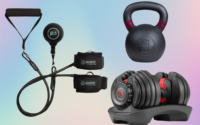Exercise pro’s 4 ways to ease into a New Year’s workout routine
It’s crunch time! Most people use the new year as motivation to kick-start their fitness goals.
If it’s been a while since you stepped foot in a gym, don’t worry, I’ve got you covered.
As the exercise physiologist supervisor at the Sports Performance Center at the NYU Langone Orthopedics Center, I have four simple steps for easing back into a workout routine and staying injury-free in the new year.
1. Devise a plan
If you have a history of heart, kidney or metabolic disease, it’s a good idea to check with your doctor before starting an exercise program. For otherwise healthy adults, we want to get you going.
First, gauge your current level of fitness by doing a step test or a six-minute walking test.
The step test requires you to go up and down a 12-inch step for three minutes at a rate of 96 steps per minute. At the end, check your pulse for a full minute. The lower the heart rate, the higher the fitness level.
For the six-minute walk, set a cone 30 meters away. You have to walk to and around the cone as many times as possible in six minutes. The distance covered can help predict fitness. If you get breathless within that time and need to sit, there’s room for improvement.
You can also check your strength and stability by doing planks and pushups. If you can’t do any, that’s a good indication to start a strength program.
Use all of this information to set your goals — and make them as specific as possible. If you want to lose weight, how much weight? Think about how you can do that, and craft your timeline based on what is realistic for what you can achieve.

For example, if a 10-pound weight loss is the goal, this can be broken down into smaller goals. To achieve weight loss, typically we need a surplus of 300 minutes of exercise per week. Is that reasonable for a new exerciser? No, but we can start at 10 minutes per day and slowly add five to 10 minutes weekly to get there.
We also need to select an appropriate timeline. This may be more of a journey than immediate gratification. You can set weekly or monthly goals, like signing up for one new exercise class, getting in three lunchtime walks, going to bed 10 minutes earlier to get up and do 10 minutes of exercise in the morning, etc.
2. Choose an exercise
A workout program should include cardiovascular exercise, strength training, flexibility work and stability exercises.
Cardio boosts heart function, helps maintain healthy blood pressure, elevates mood and lowers your risk of premature death.
We should be doing cardio — like walking, running, rowing, cycling and swimming — five to seven days a week and strength training two or three times a week.
Using free weights or a weight machine as part of a strength-training regimen promotes healthy metabolism, reduces diabetes risk and improves body composition.
Flexibility work maintains joint integrity and physical function. Examples of stability exercises include bodyweight squats, planks and side planks.
It’s important to warm up before any exercise because the movements increase body temperature, which helps deliver oxygen for energy to active muscles. Try walking, followed by lunges, squats, high knees, butt kicks, and leg and arm swings.
Doing a dynamic warmup before your workout and afterward, stretching the muscles you just used, can help prevent injury.
A good cooldown should transition our bodies from an exercise state to an arrested state. That could be anything from deep breathing to flexibility exercises to maintain integrity and muscle length.
And don’t forget sleep — sleep is a very important part of recovery. Without good sleep, our exercise efforts diminish.

3. Increase intensity
After a long break from exercise, you should start at about 50% of where you left off and progress slowly, about 10% more each week.
An ideal exercise program would be 150 minutes a week stretched out over five days, allowing you to incorporate days off.
Frequency of rest depends on your fitness level. Two or three rest days could be a good starting place — you can decrease the number of rest days as you get more fit.
It’s always good to check with an exercise professional before moving on to more difficult exercises. Everybody has different limitations — and joint mobility can vary.
It’s important to know these limits before progressing so you can avoid injury. Signs that you’ve increased intensity too fast include soreness that lasts more than two days and aches or pains that don’t go away after your workout.
4. Look to the future
Progress is when you see improvement in the exercises. For example, if you’re doing strength training, the weights get easier to lift. That means it’s time to increase those weights.
Typically for strength training, we say every week or every two weeks you can increase the weight when you are getting at least two days per week in consistently.
For cardio, that can mean increasing the duration by five minutes or so per exercise or per week, as well as boosting intensity. If you’re doing things like running, you should increase volume per week by 10%.
Ultimately, it’s important to stay accountable. You can do this by working out with a buddy, signing up with a trainer who’s waiting for you at the gym, telling everybody you know that you are doing the workout so they will ask you how you’re doing and writing in a journal so you can see the accountability for yourself.
Heather Milton, MS, is the exercise physiologist supervisor at the Sports Performance Center at the NYU Langone Orthopedics Center. She is a board-certified clinical exercise physiologist, certified strength and conditioning specialist and certified cancer exercise trainer. She develops specialized programs to help athletes reach their maximum potential and ability, creates unique and motivational programs to inspire health and fitness clients and designs injury prevention programs for at-risk athletes.


